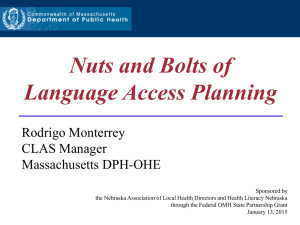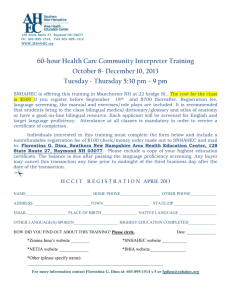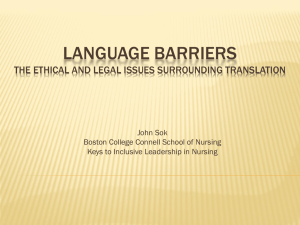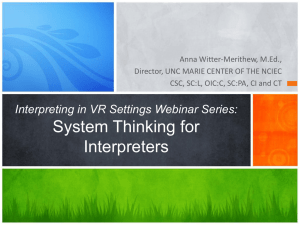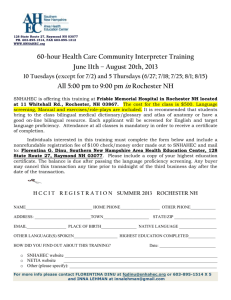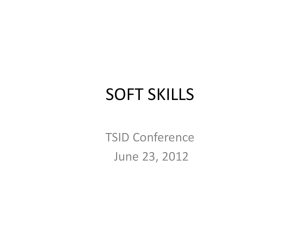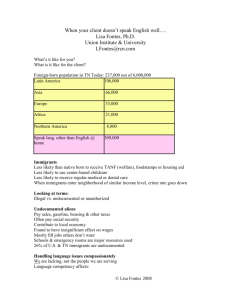Language Access at Edward M. Kennedy Community Health Center
advertisement
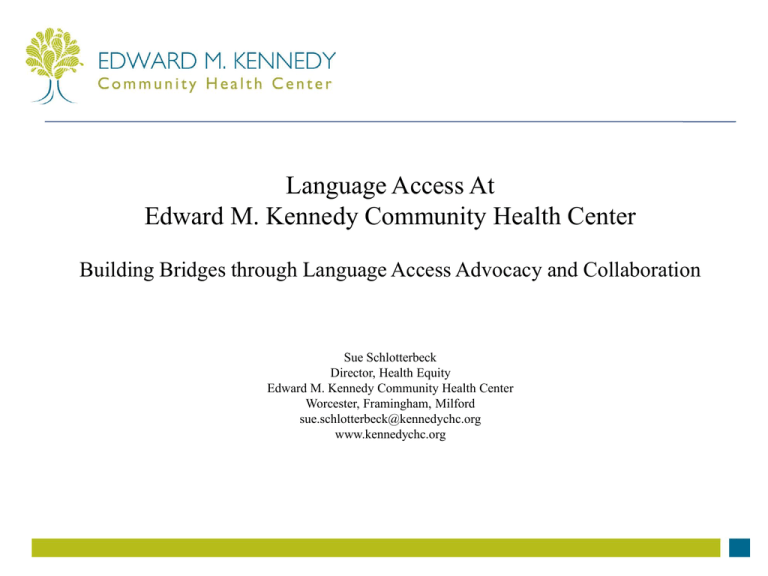
Language Access At Edward M. Kennedy Community Health Center Building Bridges through Language Access Advocacy and Collaboration Sue Schlotterbeck Director, Health Equity Edward M. Kennedy Community Health Center Worcester, Framingham, Milford sue.schlotterbeck@kennedychc.org www.kennedychc.org • Community Health Center in Worcester, Framingham, Milford, MA • We provide over 140,000 visits per year to over 24,000 patients • Founded in 1972 by 7 mothers from Great Brook Valley • Patients speak 93 languages • Staff speak 34 languages and represent 35 ethnic groups • 75% of our staff are bilingual, of which 25% are trilingual • At least 51% of board membership must be patients “We help people live healthier lives.” Health Equity Health Equity is attainment of the highest level of health for all people. Achieving health equity requires valuing everyone equally with focused and ongoing societal efforts to address avoidable inequalities, historical and contemporary injustices, and the elimination of health and healthcare disparities. Source: US Department of Health and Human Services, National Partnership for Action to End Health Disparities Health Equity 1. 2. 3. 4. 5. 6. Organizational Commitment Staff Training and Education Workforce Diversity Language Services Community Engagement Address Health Disparities Organizational Commitment Why is Health Equity and Language Access important? • Federal and State Standards (IOM, Affordable Care Act, Office of Civil Rights, Office of Management and Budget, Office of Minority Health) •Patient Centered Medical Home (PCMH) Standard 1- Enhance Access and Continuity Element F4- Culturally and Linguistically Appropriate Services (CLAS) • Assessing the language needs of its population • Providing interpretation or bilingual services to meet the language needs of its population • Providing printed materials in the languages of its population (for languages that are spoken by at least 5% of patient population) • Health Disparities Exist • Health Equity and Language Access are Connected to Quality and Safety • Values, Vision, Strategic Action Plan Organizational Commitment 2002 – Health Equity/Cultural Competence Committee to improve health equity and cultural competence • Provider Champion(s) • Diverse Team • Work Plan • Address CLAS Standards • Pilot Ideas (PDSA cycle) • Policies and Procedures • Communicate Organizational Commitment Policies and Procedures: • Culturally Responsive Care Policy • Limited English Proficiency Policy • Interpreter Services Procedures • Procedures for Translating Documents • Language Testing Policy • Patient Communication Policy • Patient Education Policy • Teach Back Procedures Language Services •Languages of populations you serve and want to serve • Interpreter qualifications • Recruitment and Collaboration • In Person and Telephonic • Track Language Needs, Productivity, Costs • Feedback from Providers and Patients • Translations • Working with Interpreters • Health Literacy Interpreter Services Procedures Verbal and written notices about language assistance Flag, EHR report, interpreter extension, page Staff Interpreter Staff approved to provide medical interpretation with other positions Telephonic Interpreter Per Diem Interpreters TTY # on PORTAL Pre-book hard to find languages and ASL interpreters Training Staff To Work With Interpreters TIPS FOR WORKING WITH INTERPRETERS • Always look at the client (not the interpreter) when you are speaking or the interpreter is speaking. • Use simple language and short sentences. • Pause after a full thought for interpretation to be accurate and complete. • Avoid asking multiple questions without breaks. • Speak in the first person rather than asking the interpreter to tell something to the patient. • Remember that everything you say will be interpreted. • Use “teach back” to confirm patient understanding. • Repeat yourself in different words if your message is not understood.


